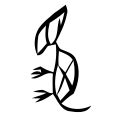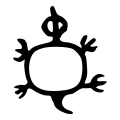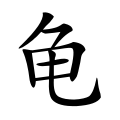Big-5 or Big5 is a Chinese character encoding method used in Taiwan, Hong Kong, and Macau for traditional Chinese characters.

In internationalization, CJK characters is a collective term for graphemes used in the Chinese, Japanese, and Korean writing systems, which each include Chinese characters. It can also go by CJKV to include Chữ Nôm, the Chinese-origin logographic script formerly used for the Vietnamese language, or CJKVZ to also include Sawndip, used to write the Zhuang languages.
Han unification is an effort by the authors of Unicode and the Universal Character Set to map multiple character sets of the Han characters of the so-called CJK languages into a single set of unified characters. Han characters are a feature shared in common by written Chinese (hanzi), Japanese (kanji), Korean (hanja) and Vietnamese.
In computing, Chinese character encodings can be used to represent text written in the CJK languages—Chinese, Japanese, Korean—and (rarely) obsolete Vietnamese, all of which use Chinese characters. Several general-purpose character encodings accommodate Chinese characters, and some of them were developed specifically for Chinese.

GB 18030 is a Chinese government standard, described as Information Technology — Chinese coded character set and defines the required language and character support necessary for software in China. GB18030 is the registered Internet name for the official character set of the People's Republic of China (PRC) superseding GB2312. As a Unicode Transformation Format, GB18030 supports both simplified and traditional Chinese characters. It is also compatible with legacy encodings including GB/T 2312, CP936, and GBK 1.0.
Extended Unix Code (EUC) is a multibyte character encoding system used primarily for Japanese, Korean, and simplified Chinese (characters).

The Chinese Character Code for Information Interchange or CCCII is a character set developed by the Chinese Character Analysis Group in Taiwan. It was first published in 1980, and significantly expanded in 1982 and 1987.
The CNS 11643 character set, also officially known as the Chinese Standard Interchange Code or CSIC, is officially the standard character set of Taiwan. In practice, variants of the related Big5 character set are de facto standard.

Mojikyō, also known by its full name Konjaku Mojikyō, is a character encoding scheme created to provide a complete index of characters used in the Chinese, Japanese, Korean, Vietnamese Chữ Nôm and other historical Chinese logographic writing systems. The Mojikyō Institute, which published the character set, also published computer software and TrueType computer fonts to accompany it. The Mojikyō Institute, chaired by Tadahisa Ishikawa (石川忠久), originally had its character set and related software and data redistributed on CD-ROMs sold in Kinokuniya stores.
The Kangxi radicals, also known as Zihui radicals, are a set of 214 radicals that were collated in the 18th-century Kangxi Dictionary to aid categorization of Chinese characters. They are primarily sorted by stroke count. They are the most popular system of radicals for dictionaries that order characters by radical and stroke count. They are encoded in Unicode alongside other CJK characters, under the block "Kangxi radicals", while graphical variants are included in the block "CJK Radicals Supplement".
Shinjitai are the simplified forms of kanji used in Japan since the promulgation of the Tōyō Kanji List in 1946. Some of the new forms found in shinjitai are also found in simplified Chinese characters, but shinjitai is generally not as extensive in the scope of its modification.
The Chinese, Japanese and Korean (CJK) scripts share a common background, collectively known as CJK characters. During the process called Han unification, the common (shared) characters were identified and named CJK Unified Ideographs. As of Unicode 16.0, Unicode defines a total of 97,680 characters.

Chinese characters may have several variant forms—visually distinct glyphs that represent the same underlying meaning and pronunciation. Variants of a given character are allographs of one another, and many are directly analogous to allographs present in the English alphabet, such as the double-storey ⟨a⟩ and single-storey ⟨ɑ⟩ variants of the letter A, with the latter more commonly appearing in handwriting. Some contexts require usage of specific variants.
Jiong is a once obscure Chinese character meaning a "patterned window". Since 2008, it has become an internet phenomenon and widely used to express embarrassment and gloom because of the character's resemblance to a sad facial expression.
KS X 1001, "Code for Information Interchange ", formerly called KS C 5601, is a South Korean coded character set standard to represent Hangul and Hanja characters on a computer.
In mathematics, the radical symbol, radical sign, root symbol, radix, or surd is a symbol for the square root or higher-order root of a number. The square root of a number x is written as
CJK Unified Ideographs Extension B is a Unicode block containing rare and historic CJK ideographs for Chinese, Japanese, Korean, and Vietnamese submitted to the Ideographic Research Group between 1998 and 2000, plus seven gongche characters for kunqu added in Unicode 13.0, and two characters for the Macao Supplementary Character Set added in Unicode 14.0.
CJK Compatibility Ideographs is a Unicode block created to contain mostly Han characters that were encoded in multiple locations in other established character encodings, in addition to their CJK Unified Ideographs assignments, in order to retain round-trip compatibility between Unicode and those encodings. However, it also contains 12 unified ideographs sourced from Japanese character sets from IBM.
CJK Compatibility Forms is a Unicode block containing vertical glyph variants for east Asian compatibility. Its block name in Unicode 1.0 was CNS 11643 Compatibility, in reference to CNS 11643.
CJK Unified Ideographs Extension I is a Unicode block comprising CJK Unified Ideographs included in drafts of an amendment to China's GB 18030 standard circulated in 2022 and 2023, which were fast-tracked into Unicode in 2023.












